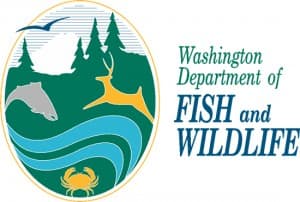Threatened Chum Salmon Run on Washington’s Lewis River Gets New Recruits
OutdoorHub 05.23.12

The future of chum salmon in the Lewis River Basin may depend on 105,000 juvenile fish released into the east fork last week by the Washington Department of Fish and Wildlife (WDFW).
The chum fry, each about two inches long, are part of a coordinated effort to restore a salmon species that once returned to the Columbia River by the millions, but is now at risk of extinction.
Fishery managers expect that about 500 of the juvenile fish will return to the East Fork Lewis River as adults over the next three to five years. Currently, the entire Lewis River system attracts only about 50 spawning chum each year, compared to historical returns upwards of 100,000 said Todd Hillson, a WDFW fish biologist.
“We have a long way to go to rebuild this run, but this is where it starts,” Hillson said. “Over time, as the returns increase and the year-classes start to overlap, we expect that these efforts will move us toward a sustainable chum salmon population in the East Fork Lewis River and the rest of the Columbia River Basin.”
Last week’s fry release is part of a long-term recovery project for chum salmon initiated by WDFW in the late 1990s with financial support from the Bonneville Power Administration. Similar projects are already under way on Grays River near the mouth of the Columbia and at Duncan Creek, a small tributary near Bonneville Dam.
The Oregon Department of Fish and Wildlife also launched a reintroduction project for chum salmon on Big Creek near Astoria last year with eggs provided by WDFW from the Grays River chum program.
Fishery managers attribute the decline of chum salmon in the lower Columbia River to overfishing in the early 1900s and losses in spawning and rearing habitat from diking, dam construction and other developments. After years of dwindling runs, chum salmon were listed as “threatened” in the lower Columbia River under the federal Endangered Species Act in 1998.
For the new project on the East Fork Lewis River, juvenile chum salmon were reared for approximately six weeks at the Lewis River Hatchery. Those juvenile fish are the offspring of 111 adult chum that returned to spawn on the Columbia River near the Interstate 205 Bridge.
“We chose those fish because that run has the greatest genetic similarity to native Lewis River chum,” Hillson said. “In addition, returns to that area are large enough to sustain the loss of those fish.”
Hillson said releasing juvenile fish is the “fun part” of salmon restoration. Before any fish are actually released, WDFW employees and area volunteers often work for weeks to restore spawning channels and other habitat the salmon need to survive.
“Rearing and spawning habitat is probably the greatest limitation we face in restoring chum salmon in the Lewis River and the lower Columbia,” Hillson said. “Even though fisheries were brought under control by the 1950s, the chum never really came back because so few places were left for them to successfully spawn.”
That will not be the case with the chum fry released last week.
Approximately 95,000 of those fish were released just below a spawning channel designed and built on the East Fork Lewis River by Fish First, a local salmon-recovery group. Dean Swanson, who serves on Fish First’s board of directors and owns the property, has been active in many of the group’s other restoration projects for salmon and steelhead in the Lewis Basin.
The remaining 10,000 fry were released into Mill Creek, a tributary of the East Fork Lewis River, from property owned by Dave Brown, who operates a rescue facility for wild fish. Brown and his team of volunteers specialize in rescuing outmigrating salmon and steelhead at risk of becoming stranded in shallow water.
“Both Dean and Dave have been working to restore wild fish for a long time,” Hillson said. “I can’t imagine having better partners for this project.”
While chum salmon have less value to freshwater fisheries than other salmon species, they have played a historic role in the ecology of the Columbia River Basin, said Bryce Glaser, another WDFW fish biologist.
“Chum salmon once carried massive amounts of nutrients from the ocean up the Columbia River, where their carcasses benefit the stream, the soil and other fish and wildlife,” he said. “Our goal is to rebuild these runs and regain the ecological benefits they bring with them.”

